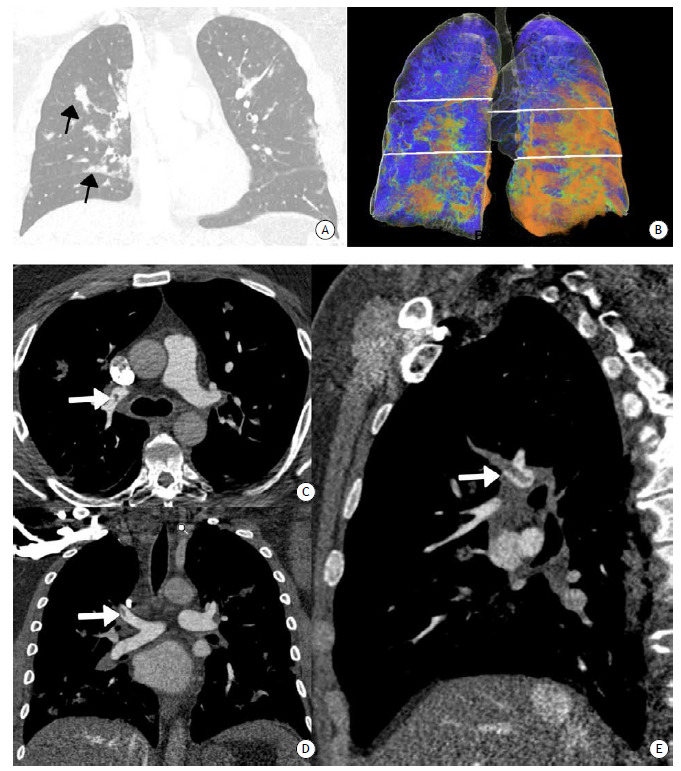In December of 2019, a new virus was discovered in Wuhan, China. It was characterized as a coronavirus and is responsible for the COVID-19 pandemic. A small number of those affected by the virus develop acute respiratory distress syndrome and other complications, of which the most recently reported is acute pulmonary thromboembolism (PTE). 1 Although the mechanism by which this viral infection increases the risk of acute PTE has yet to be fully understood, it might be related to the endothelial damage caused by the viral infection. 1
The aim of the present report is to show the possible causal relationship between COVID-19 pneumonia and acute PTE. An obese 40-year-old man was initially diagnosed with mild COVID-19. Seven days after the onset of the symptoms, he presented with worsening dyspnea and an increase in D-dimer levels (from 700 ng/mL to 7,000 ng/mL). At hospital admission, CT angiography of the chest showed a typical pattern of viral pneumonia 2 and PTE (Figure 1). There was no hypoxemia. Doppler ultrasound of the lower extremities was negative for deep vein thrombosis, and an echocardiogram was unremarkable. In the case of COVID-19 pneumonia reported here, the absence of major risk factors for venous thrombosis supports the hypothesis that the viral pneumonia was the triggering factor for acute PTE. 3
Figure 1. A CT scan of the chest showing foci of consolidation (in A) one week after an initial scan had shown only opacities and ground-glass attenuation, consistent with the usual evolution of COVID-19 pneumonia. A posterior projection of the lungs using three-dimensional reconstruction (in B) shows the extent of lung parenchyma involvement (37.7%), predominantly in the posterior region. CT angiography of the chest showing a central filling defect-white arrows in C (axial reconstruction), D (coronal reconstruction), and E (sagittal reconstruction)-in the branch of the right pulmonary artery to the upper lobe, consistent with acute pulmonary thromboembolism.

REFERENCES
- 1.Danzi GB, Loffi M, Galeazzi G, Gherbesi E. Acute pulmonary embolism and COVID-19 pneumonia: a random association. Eur Heart J. 2020 doi: 10.1093/eurheartj/ehaa254. [DOI] [PMC free article] [PubMed] [Google Scholar]
- 2.Lei J, Li J, Li X. CT imaging of the 2019 novel coronavirus (2019-nCoV) pneumonia. Radiology. 2020;295(1):18–18. doi: 10.1148/radiol.2020200236. [DOI] [PMC free article] [PubMed] [Google Scholar]
- 3.Xie Y, Wang X, Yang P, Zhang S. COVID-19 Complicated by Acute Pulmonary Embolism. Radiol Cardiothoracic Imaging. 2020;2(2):e200067. doi: 10.1148/ryct.2020200067. [DOI] [PMC free article] [PubMed] [Google Scholar]


